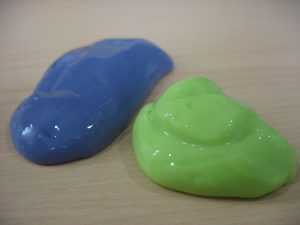Our kits are currently being reviewed and updated by a team of collaborative, innovative and interdisciplinary educators who wish to enhance the educational opportunities for students. These dedicated teachers are members of CRISP Collaborative Science for All (CCSA) as well as local educators.
Click to see the SCSU CRISP Module Template used by CCSA for improving and updating the CRISP demos and kits. Each kit page offers a CRISP developed teacher module and CRISP aligned standards (both NGSS and CCSS)
Kit Request form

Polymers are composed of a large number of repeating units. The word is derived from the Greek words poly (meaning “many”) and mer (meaning “part”). There are both naturally occurring and synthetic polymers. Some examples of naturally occurring polymers are proteins, starches, cellulose, and latex. Synthetic polymers are mad-made, on a large scale and have a wide range of properties and applications. A good example of a synthetic polymer is plastics – water bottles, sand buckets, plastic sunglasses and so many more types are produced every day.
Created by CRISP
Subject(s):
Polymers
Objectives:
- Students will be introduced to the concept of polymers, their structures and properties.
- Students will understand:
- What a polymer is
- What is means to be a cross-linked polymer
- What elasticity is, and what it means for a material to have elastic properties
Vocabulary:
Polymer, Monomer, Cross-link, Molecule
Materials in this kit:
- All-purpose white glue
- Saturated solution of sodium tetraborate (Borax detergent in water) in 10mL test tubes
- Food coloring
- Small cups
- Stirring sticks
- Eye droppers
Suggestions for the Teacher:
Try to split up the class. Have each group use a set amount of the Borax solution (1 dropper full, 2 droppers full, 3 droppers etc.) and let them compare their results. Ask students how they can make the Gak/Silly Putty slimier, or more solid. What’s going on at the nanoscale that is making the solution like that?
Safety:
Do not ingest the sodium tetraborate (Borax) solution or Glue. Materials can be disposed of in regular trash
Additional Resources:
Gak/Silly Putty CRISP aligned standards
Gak/Silly Putty Teacher Module
STEM Careers:
Materials Scientist
Researcher
Research and Development
Bioengineer
Engineer
Manufacturing Technician
Standards:
5-PS1-1
- Develop a model to describe that matter is made of particles too small to be seen.
MS-PS1-2 Matter and its Interactions
- Analyze and interpret data on the properties of substances before and after the substances interact to determine if a chemical reaction has occurred.
HS-PS2-6
- Communicate scientific and technical information about why the molecular-level structure is important in the functioning of designed materials.
MS- PS1.A: Structure and Properties of Matter
- Each pure substance has characteristic physical and chemical properties (for any bulk quantity under given conditions) that can be used to identify it.
CC-3 Scale, Proportion, and Quantity
- Natural objects exist from the very small to the immensely large.
MS - Patterns
- Macroscopic patterns are related to the nature of microscopic and atomic-level structure
SEP 2- Developing and Using Models
- Use models to describe phenomena.
SEP 4 – Analyzing and Interpreting Data
- Analyze and interpret data to determine similarities and differences in findings.
SEP 6 – Constructing conclusions and designing solutions
- Construct and revise an explanation based on valid and reliable evidence obtained from a variety of sources (including students’ own investigations, models, theories, simulations, peer review) and the assumption that theories and laws that describe the natural world operate today as they did in the past and will continue to do so in the future.
